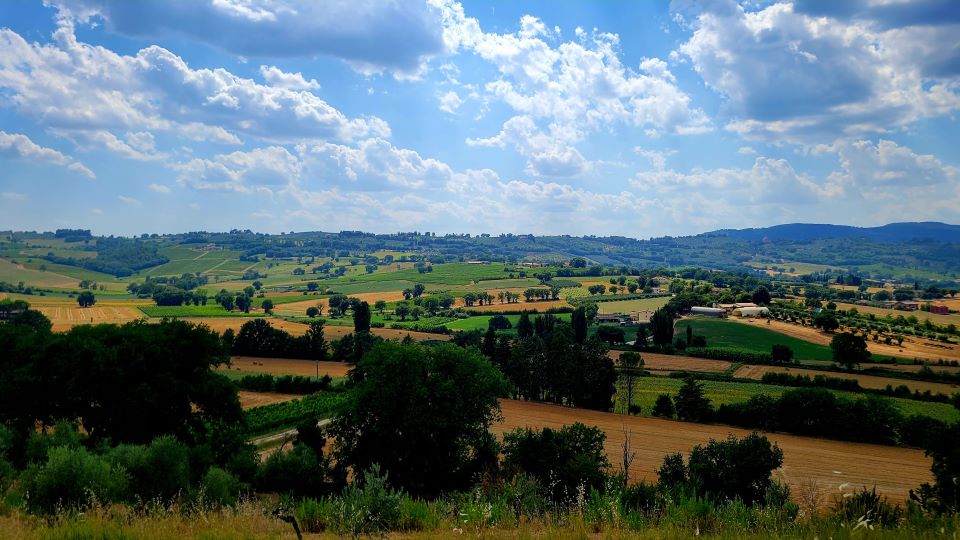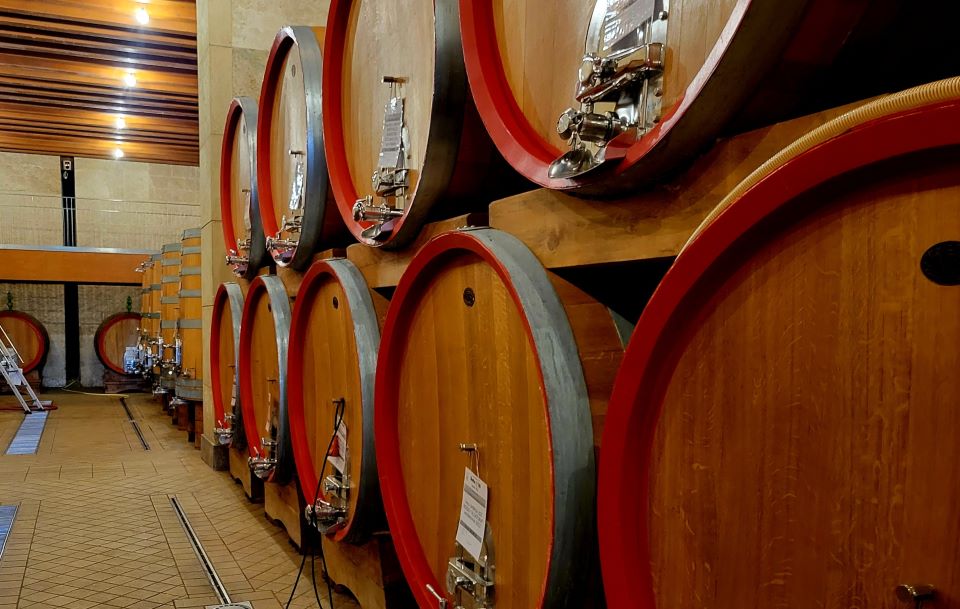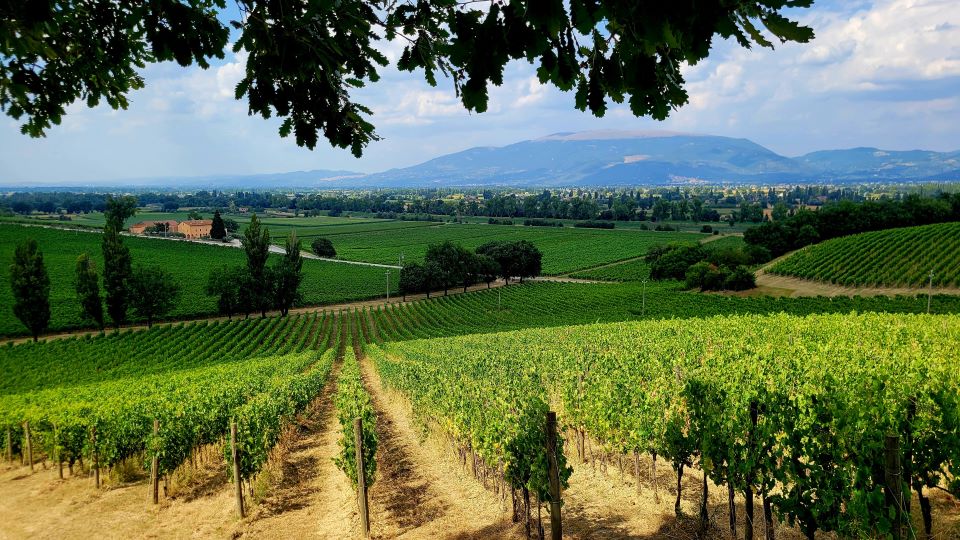Browse using the new Vinous website now. Launch →
Printed by, and for the sole use of . All rights reserved © 2015 Vinous Media
Umbria: Peeling Back the Layers
BY ERIC GUIDO | OCTOBER 10, 2024
Returning to Umbria is always an eye-opening experience. Deciphering the vast mix of vintages, producer styles and varieties is a rewarding process. The region inches forward with each passing year, notably beyond its two major growing areas, Montefalco and Orvieto. Look to Sangiovese from Torgiano, championed by the Lungarotti family, for a more rugged character, or to Gamay, which finds complexity in the hands of Madrevite in Trasimeno. Moreover, I am amazed by how many good IGTs come across my tasting table on each visit. From the south, explore the playful yet serious Ciliegiolo from Bussoletti, the refined-in-amphora Trebbiano Spoletino from Annesanti and the Bordeaux blends around Lake Trasimeno. Even Pinot Noir, produced by two of the region's benchmarks, Arnaldo Caprai and Castello della Sala, are worth seeking out. Umbria’s diversity is its greatest strength.

Montefalco’s gently rolling hills.
As I have discussed in previous articles, the region’s multifaceted terrain allows the production of a vast array of grape varieties and styles. Umbria cannot be encapsulated into one easy-to-swallow pill for readers. For starters, the main growing areas of Montefalco and Orvieto experience significantly different growing seasons.
Montefalco, a hilltop town surrounded by vineyards, looks like a massive crater encircled by the Apennine Mountains on all sides. Weather systems become easily trapped within or outside this area, forming contrasting conditions compared to Tuscany to the west and Abruzzo to the east. Summer days in Montefalco are sweltering, while at night, cold winds swoop in from the surrounding higher elevations to the point that you need a jacket in the middle of July. This unique combination of climate, soils and topography contributes to the depth, concentration and complexity of its primary grapes: Sagrantino, Sangiovese, Trebbiano Spoletino and Grechetto.
Moving on to Orvieto, one of Italy’s most famous wine towns for decades, a handful of high-quality growers work to keep production relevant despite the significant number of forgettable wines. This vastly vine-planted area straddles the borders of Umbria and Lazio, with the most important vineyards located in Umbria. The terroir here is defined by a combination of influences: the mountains, the Mediterranean Sea and the nearby Lake Corbara. While the wines from the interior of Umbria suffer through the warm seasons, the ones from Orvieto can still find balance, as in the outstanding 2022 vintage.
Beyond describing terroir and climate differences in Montefalco and Orvieto, approaching Umbria from a critical standpoint poses another challenge: the range of vintage releases available to taste each year. During my visits, I often go through seven or eight vintages, even within Montefalco, where, for example, I still found newly released 2016s this year. This makes it difficult to assess the results of the growing seasons as I never have all or most of the wines from the same year in the same tasting. This report covers 2019 and 2020 Reds, some 2021 Rossos and mainly Trebbiano Spoletino and Grechetto from 2022 and 2023. While the abundance of vintage releases can, at times, be overwhelming for wine professionals and consumers alike, exploring this diversity is well worth the effort.

Botti in Paolo Bea’s cellar.
The Current State of the Montefalco DOC
Consumers often associate Umbria with Montefalco. Famous for its varietal Sagrantino, the Montefalco area also excels with its Rosso, typically a blend of primarily Sangiovese and Sagrantino and other indigenous or international red grapes. This is a hot topic today, as many winemakers have petitioned the Consorzio to restrict the blending rules of the Montefalco Rosso DOC to only indigenous varieties. These include Montepulciano, Colorino, Canaiolo and Barbera. While this desire aligns with current trends, many wineries, like Dionigi, Arnaldo Caprai or Fattoria Milziade Antano, have become famous for their Montefalco Rossos blended with Cabernet Sauvignon and Merlot. I have always found Rossos with international grapes to be well-balanced and complementary to the local varieties. I'm also a fan of 100% indigenous blends, especially those that use varieties like Barbera and Montepulciano to add a fruity or acid-driven profile. We have seen this story played out before, but here, it is essential to question if fixing something that isn’t broken is truly necessary.

Arnaldo Caprai’s perfectly manicured vineyards.
Umbria’s White Wine Resurgence
In recent years, Umbria has seen a resurgence in white wine production, with Trebbiano Spoletino emerging as the region’s most exciting wine category. In the Spoleto area, just south and east of Montefalco, producers have invested significantly in improving the quality of the wines under the Spoleto DOC. Here, producers are pushing the envelope primarily in the vineyards, ensuring they are using the correct clonal selections and plantings in the proper locations, as the DOC regulations are not very stringent. Don’t confuse Trebbiano Spoletino with Trebbiano Toscano; they come from the same broader family but are entirely different varieties. While Trebbiano Toscano is often used for simpler, less expressive wines, Trebbiano Spoletino offers more tropical fruits and florals elevated by juicy acidity. Tabarrini’s Adarmando, a benchmark wine, demonstrates Trebbiano’s remarkable aging potential. Paolo Bea’s Arboreus is a fantastic example of complexity achieved through older vines, while Romanelli’s Le Tese is nearly impossible to resist for its incredible freshness and drinkability.
During my tastings, I expected that other exciting whites would come from the Orvieto DOC, although they are mostly IGT wines made from Grechetto, Procanico and Chardonnay all across Umbria. Of that group, Grechetto, in particular, captivates with its stimulating character. Produced throughout Umbria, Grechetto wines aren’t highly aromatic, yet they provide fantastic depth and concentration offset by refreshing acidity and tannic crunchiness. As one of the world's most tannic white grapes, Grechetto contributes to the aging potential of a good DOC Orvieto, like an unoaked Chardonnay with more of a structural kick. Today, Grechetto is also offered in sparkling form, where its acidity wins the day.

Remnants from the earthquake of 2016, which seriously altered the terrain of Umbria, including a river that changed its direction entirely near the town of Norcia.
Current Vintages
Recent vintages of Montefalco Sagrantino are nothing short of impressive. I find these wines easier to taste and enjoy than ever before, though cellaring them will benefit their balance throughout their lifetimes. For many years, winemakers’ main focus has been on taming Sagrantino’s searing tannins, and now consumers can finally experience the fruits of their labor. Each winery employs its own taming process, with equally pleasurable results. Arnaldo Caprai’s Sagrantino undergoes a whole-berry fermentation followed by 40-to-50 days of slowly rotating each barrel once a day. This method softens the tannins while remaining prevalent and lending a beautiful balance. Tabarrini’s gentle steeping approach, a teabag-like infusion of skins and juice, gives more elegant and graceful wines with seductive textures. Paolo Bea mastered their technique many years ago, allowing the wines to ferment very slowly in large, neutral barrels, followed by extended aging.
As mentioned previously, this year, most new releases I tasted in the form of red wines were from 2020 and 2019, two distinct vintages. In 2019, Montefalco experienced a more typical growing season: warm and dry throughout the summer, balanced by diurnal temperature shifts. The 2019s are intense, powerful, structured, radiant and fruit-focused wines. Lovers of classic, long-aging Sagrantino will find much to like about them. The 2020 vintage was hot and incredibly dry through most of the season. Still, when rain finally did arrive in late September, it was accompanied by hail, causing problems for the later ripening Sagrantino and Trebbiano Spoletino. Managing disease among the vines was paramount to a successful harvest. Some producers rushed picking in fear of disease pressure, while others stayed the course and, through careful selection, ended up with gorgeous fruit. The 2020s have turned out much better than expected, yet not consistently so. Consumers should choose producer over the vintage, as those who harvested healthy fruit made lovely wines. The 2020s are soft, cool-toned, wonderfully perfumed, and, combined with proper tannin management, pleasurable wines with medium-term aging capacity.

Seashells unearthed from the Barberani vineyards in Orvieto.
Last year, I only tasted a small number of the fresh 2021 reds and whites. This year, many producers have released their 2021 Montefalco Rossos. These wines are rich and show the warm and dry conditions of the season, still with acid profiles that maintain freshness despite elevated alcohol levels. Ultimately, the wines are elegant and charming and hide their heat well. I attribute the success of the 2021s to the cooler temperatures brought by precipitations in the later part of the season. I am hesitant, though, about the potential of the 2021 Sagrantinos–to be released next year–considering the Rossos already struggle with balance with their 15-16% alcohol by volume.
Two thousand twenty-two was a vintage of extremes, with a considerably warm and dry winter and spring. June saw record-breaking temperature spikes, and drought conditions persisted through July. While vines produced a healthy amount of buds, berries were small due to the hydric stress. Although disease risk was low, vines’ health was a concern as they shut down due to the extreme temperatures and lack of water. In Orvieto, rains in early August released stress in the vineyards, with cooler temperatures. Meanwhile, Montefalco experienced similar conditions later in the month. Although the damage had already been done, vines somewhat recovered with the persistent cooler trend into harvest. These conditions resulted in an early picking–generally a week earlier than usual–and lower yields. Based on my tastings so far, the 2022 whites are perfumed, rich and opulent, while the reds come across as soft-textured and pliant, lacking energy and complexity. However, they will be enjoyable without much cellaring.
I tasted the wines for this article in Umbria in July and in our office in New York City in August 2024.
© 2024, Vinous. No portion of this article may be copied, shared or re-distributed without prior consent from Vinous. Doing so is not only a violation of our copyright, but also threatens the survival of independent wine criticism.
You Might Also Enjoy
Tipping the Scales: New Releases from Umbria, Eric Guido, October 2023
Umbria: Taking It to the Next Level, Eric Guido, November 2022
Umbria & Lazio: Italy’s Underdogs, Eric Guido, August 2021
Show all the wines (sorted by score)
- Adanti
- Annesanti
- Antonelli San Marco
- Argillae
- Arnaldo Caprai
- Barberani
- Bocale
- Bussoletti
- Castello della Sala
- Colle Ciocco
- Decugnano dei Barbi
- Dionigi
- Famiglia Cotarella
- Fattoria Milziade Antano
- Fongoli
- Fratelli Pardi
- Giampiero Bea
- Le Cimate
- Lungarotti - Grechetto
- Lungarotti - Montefalco
- Lungarotti - Torgiano
- Madrevite
- Montioni
- Paolo Bea
- Plani Arche
- Pomario
- Romanelli
- Scacciadiavoli
- Tabarrini
- Tenuta Alzatura
- Tenuta Bellafonte
- Tenute Lunelli - Tenuta Castelbuono
- Valdangius
- Viandante del Cielo
